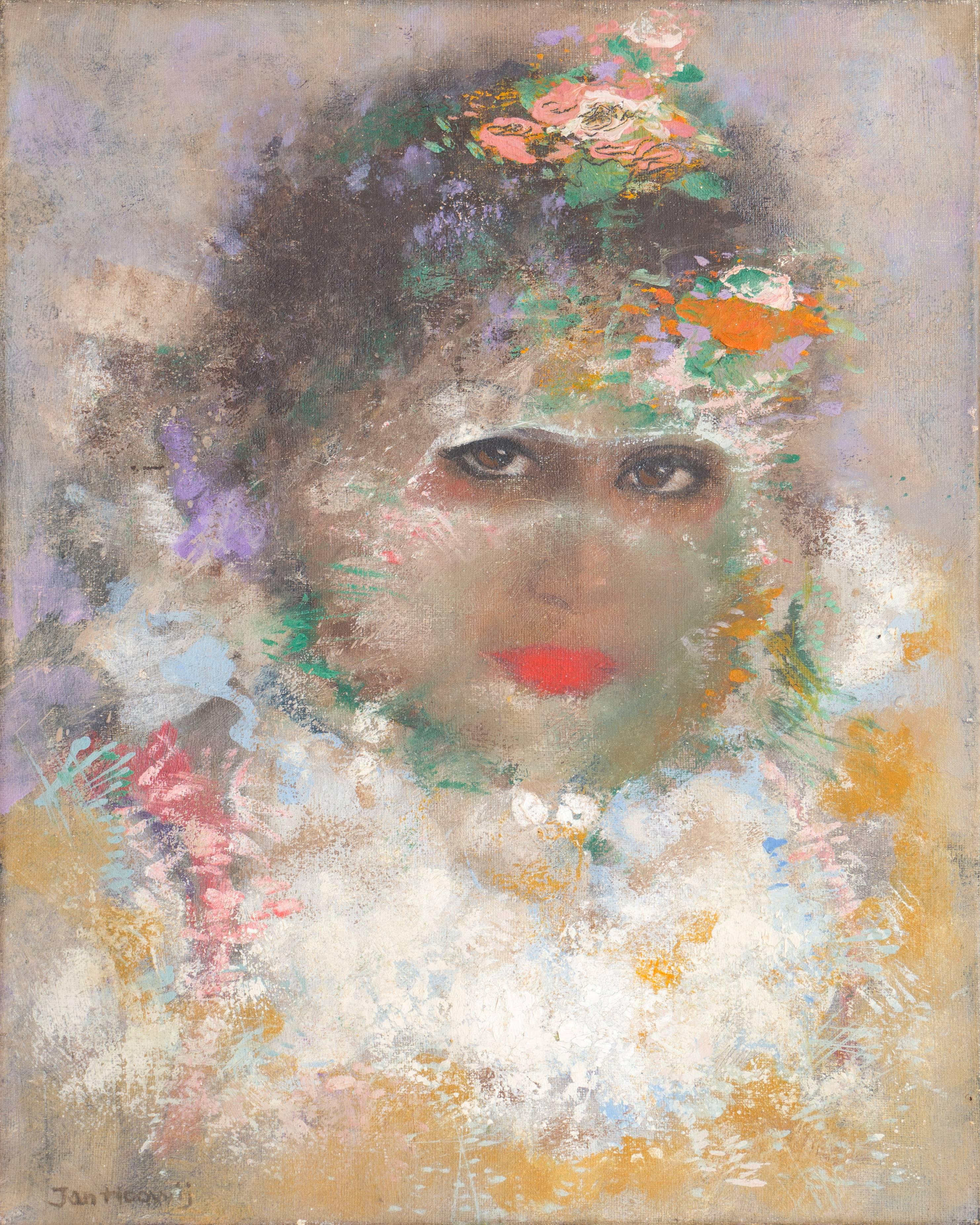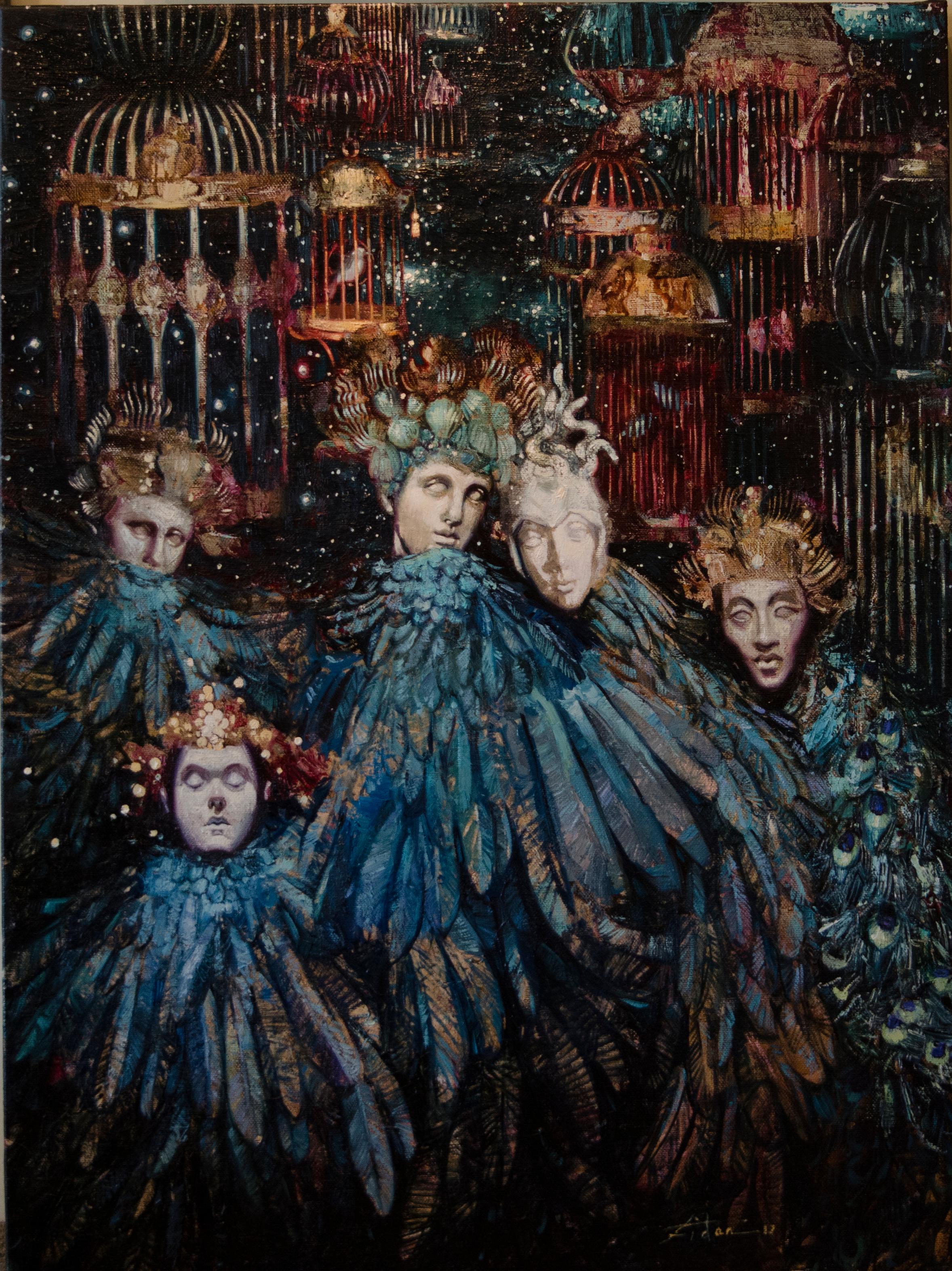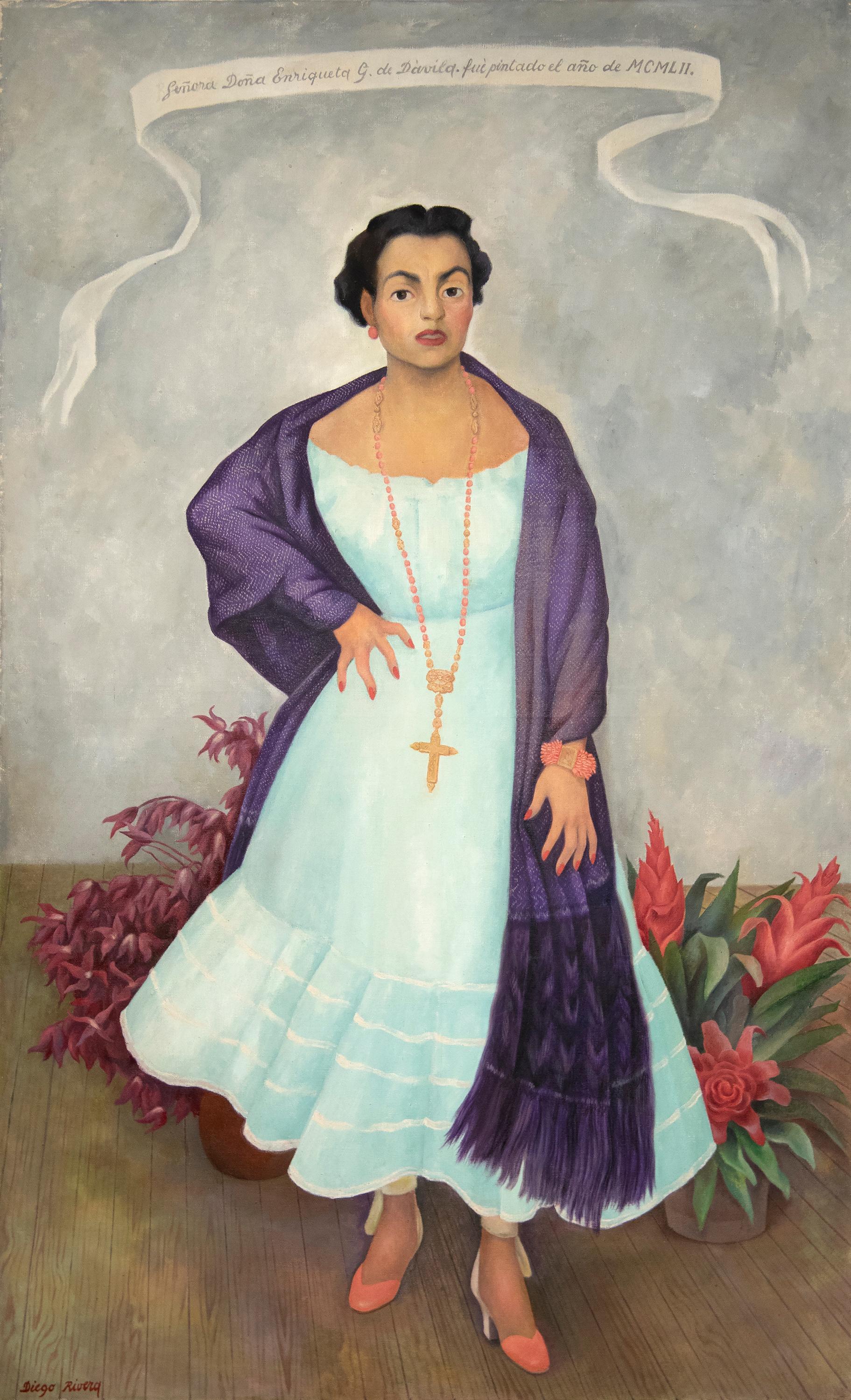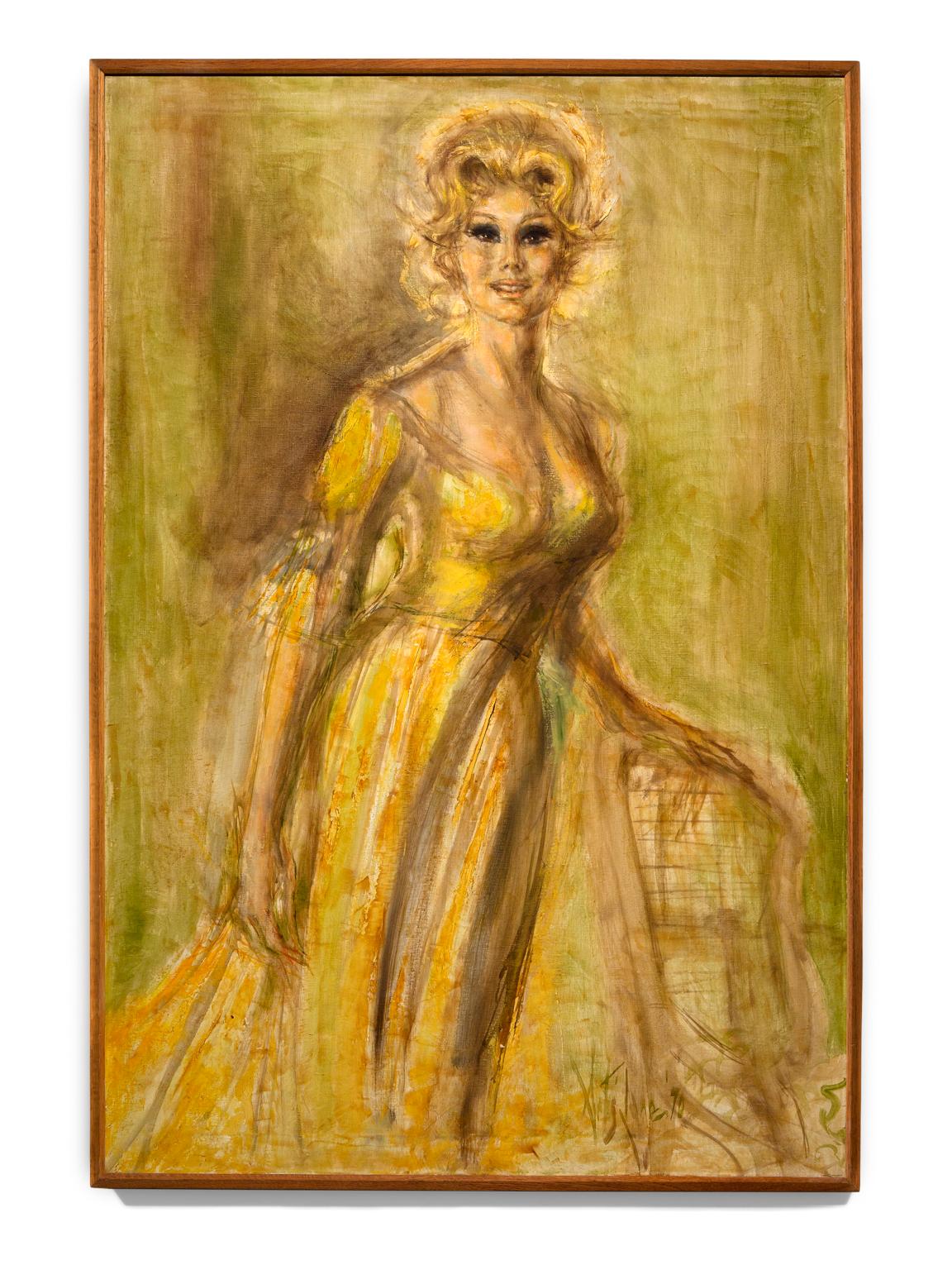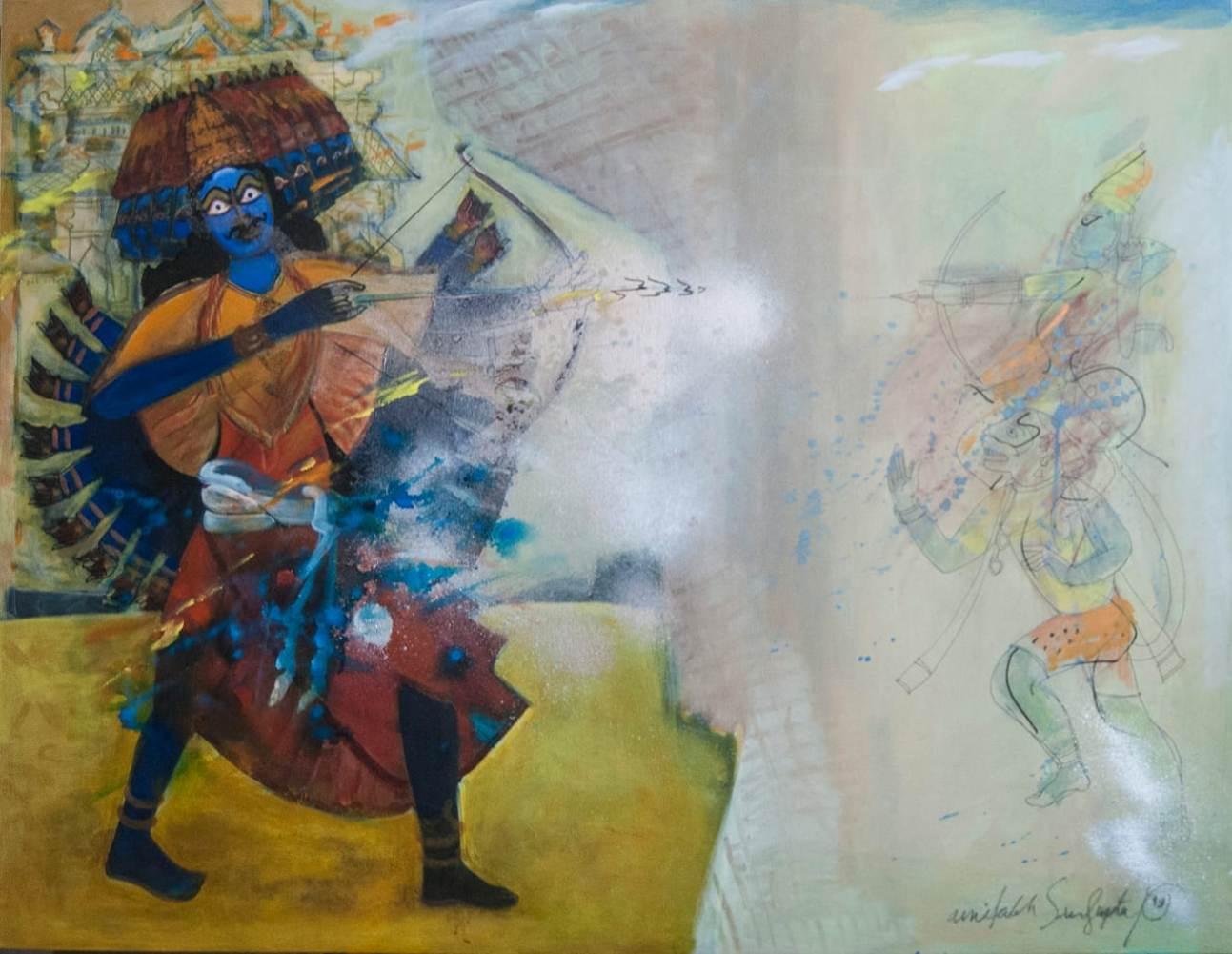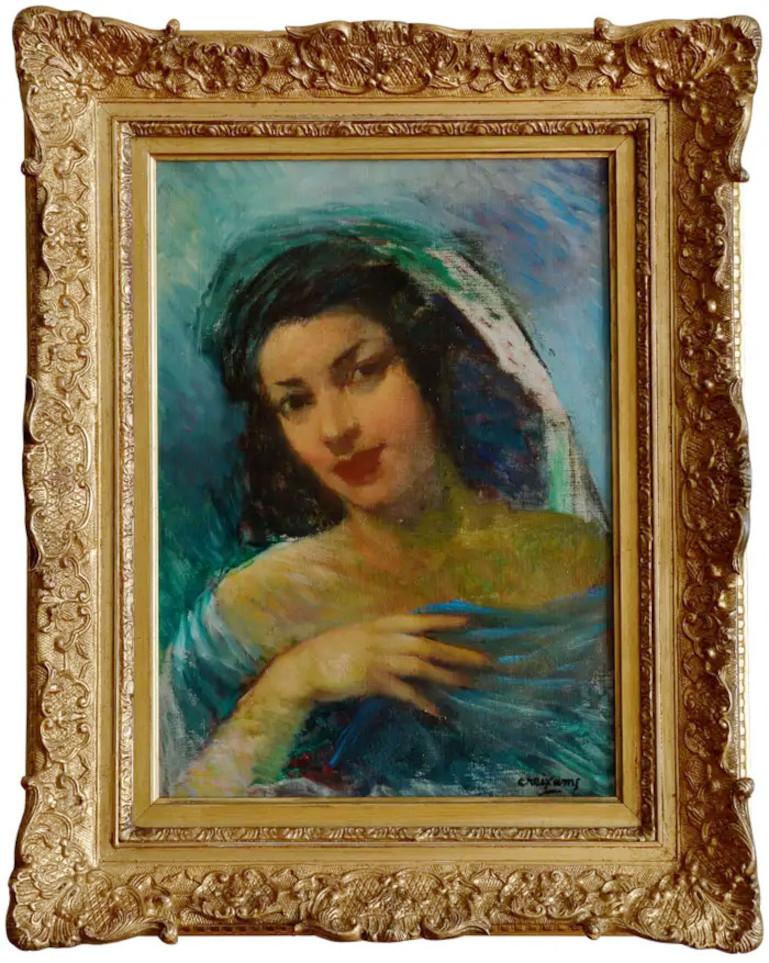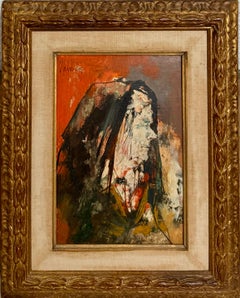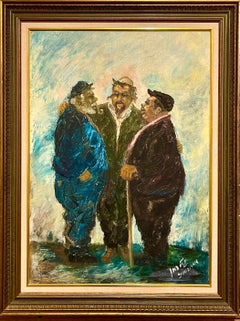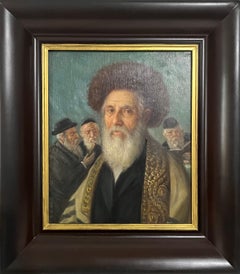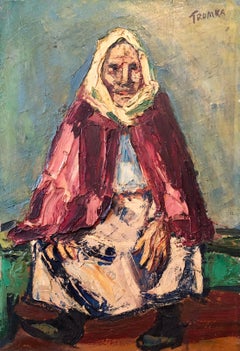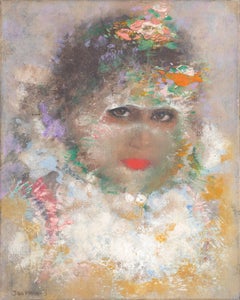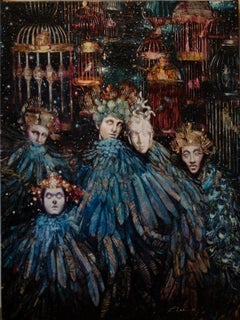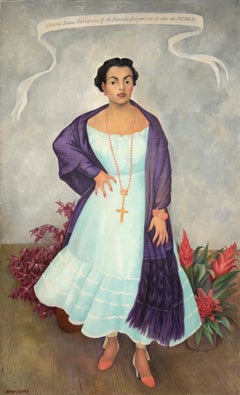Items Similar to Proud Chimney Sweep Modern Judaica Shtetl Oil Painting WPA Jewish artist
Want more images or videos?
Request additional images or videos from the seller
1 of 10
Maurice KishProud Chimney Sweep Modern Judaica Shtetl Oil Painting WPA Jewish artist
About the Item
Genre: Modern
Subject: Klezmer Musicians
Medium: Oil
Surface: Board, size includes artist decorated frame
Country: United States
The imagery of Maurice Kish (1895-1987), whether factories or carousels, reliably subverts expectations. His vision hovers just around the unraveling edge of things, where what is solid and clear becomes ambiguous. He is fascinated, often delighted, by the falling apart. This unexpected, fresh perspective results in oddly affecting pictures of a now long-gone New York.
Born Moishe in a town called Dvinsk, Russia (what is now Daugavpils, Latvia), Kish came with his family to New York when he was in his teens. The family settled in Brownsville, and for the rest of Kish’s life Brooklyn remained his home, though he moved from one neighborhood to another. He was close to his parents, who recognized his talent and supported his desire to become an artist.
Kish attended the National Academy of Design as well as Cooper Union. His fellow students included many other immigrants and children of immigrants who were particularly receptive to the Modernism coming from Europe. As his career progressed, Kish himself applied different strains of Modernism to different purposes. For him, the story was held above all else.
For years, Kish used the skills he acquired in art school to earn his living at a Manhattan glass factory where he painted floral designs on vases. During the Depression, Kish became a WPA painter in the Federal Art Project (FAP). FAP artists were given a mandate to create works that celebrated labor. The artists tended to be socially progressive, as Kish certainly was. Kish's work from this period, with its dark colors and rolling clouds, reveals the influence of Social Realists like Thomas Hart Benton. Apparent, too, is Kish's interest in the urban monumentality of Charles Sheeler. Kish's structures, however, lack Sheeler's almost dehumanized precision. Rather than the soulless, sleek machines of a typical modern urban dystopia, Kish's factories are shaggy old beasts as worn out as the laborers who troop through their doors. In End of Day's Toil, now at the Smithsonian, the viewer feels some affection for that rambly grandfather of a building all the tired small workers are leaving behind.
Much of Kish's work, for the FAP and elsewhere, undermines received truths in a similar way. Some early works with themes from Yiddish culture are overtly humorous: a painting of a big jolly wedding guest, looking invitingly over her shoulder; a Rabbi, a big fiddler on a small roof. Later, the humor becomes more ironic and reflective. In another work, the rather imposing organ grinder of the late 1930s looms above a child, yet his intermediary the cockatoo is bright and appealing, and offers the girl a fortune with his beak. This could read as an allegory for capitalism as easily as a straightforward colorful street scene. A small painting of a snowy day in Washington Square gives a bird's eye view of people bent against the wind walking alone or in pairs. The huge triumphal arch at the middle of it has no connection to their movements or their lives. Kish makes its size and centrality a quiet joke about the futility of grandiose gestures. Like the buildings in his FAP works, the arch has a personality. It is a landmark that looks a bit lost.
A favorite location for Kish was Coney Island. For the laborers of the city, this was a place of great freedom and possibility. There were no bosses! Anyone could go to ride the rides and swim in the sea. For Kish, Coney Island, and especially Luna Park, became a place richly symbolic of workers’ rights. For the dreamlike paintings he set there, Kish looked past the Social Realists to the Expressionists. His colors are brilliant and his lines are wild. These images, joyfully unrestrained, give full voice to an anarchic vision merely hinted at in other works. If the structures of the earlier pictures came further out of the background than expected, these Coney Island structures completely take over the scene.
Kish made several variations on the theme of the carousel as a site of revolution. In the moonlight, the horses have broken from their poles and spin away from the calm center. The workers have come to manic life, have released themselves from the yoke of labor and have abandoned their master, the merry-go-round. They escape to different corners of the pleasure park, dance together and ride the ferris wheel. One horse pretends to be a ticket seller. It is another allegory, one that depicts a worker's holiday paradise in carnival fashion.
A painter who embraced ambiguity, Kish was himself a man who occupied many worlds simultaneously. Even during the period when he had shows at prestigious galleries and belonged to several artists' groups, he identified most strongly as an outsider, a Yiddischer. He wrote poetry in Yiddish throughout his life. In 1968, he published a volume of fifty years of these poems, Di Velt ist Mayn Lid (The World is My Song) in Yiddish, with no English translation, for his peers. Kish also translated English-language poetry into Yiddish and acted as a guide to help other Yiddish writers. Long after the art organizations ceased to provide meaning and fulfillment, Kish was a devoted member of the Yiddish Culture Association.
In addition to painting and poetry, Kish was a dancer who taught during the summers at various Jewish resorts in the Catskills. Small but lithe, he also spent some years as an amateur boxer. Well into his eighties, Kish was proud of the quality of his handball game.
By the 1940s, Kish’s career was going well, but his descriptive style of working began to fall out of fashion, supplanted by a more formal Abstraction. Kish was never able to support himself solely through his art, yet in the midst of all of his other activities, Kish continued to create his distinctive images of an immigrant's New York. He departed far from the mainstream, and in later years, seldom showed his work, preferring to keep it for himself (although he sometimes traded paintings for rent).
Of making art, Kish said, "It is a sacred mission to enrich, to elevate and to make our lives more complete." His works, though frequently playful, encourage a second look at ordinary things. His irreverence elevates by revealing flaws where his audience, all workers and outsiders of a kind, can get a purchase. Kish's art fondly celebrates the beauty of the irregular.
- Creator:Maurice Kish (1895-1987, American)
- Dimensions:Height: 20.5 in (52.07 cm)Width: 16.5 in (41.91 cm)
- Medium:
- Movement & Style:
- Period:
- Condition:minor wear. minor varnish residue.
- Gallery Location:Surfside, FL
- Reference Number:1stDibs: LU38212767762
About the Seller
4.9
Platinum Seller
Premium sellers with a 4.7+ rating and 24-hour response times
Established in 1995
1stDibs seller since 2014
1,744 sales on 1stDibs
Typical response time: 2 hours
- ShippingRetrieving quote...Shipping from: Surfside, FL
- Return Policy
Authenticity Guarantee
In the unlikely event there’s an issue with an item’s authenticity, contact us within 1 year for a full refund. DetailsMoney-Back Guarantee
If your item is not as described, is damaged in transit, or does not arrive, contact us within 7 days for a full refund. Details24-Hour Cancellation
You have a 24-hour grace period in which to reconsider your purchase, with no questions asked.Vetted Professional Sellers
Our world-class sellers must adhere to strict standards for service and quality, maintaining the integrity of our listings.Price-Match Guarantee
If you find that a seller listed the same item for a lower price elsewhere, we’ll match it.Trusted Global Delivery
Our best-in-class carrier network provides specialized shipping options worldwide, including custom delivery.More From This Seller
View AllOil Painting Woman Portrait French Armenian Modernist Jean Jansem Ecole De Paris
By Jean Jansem
Located in Surfside, FL
Jean Jansem (Hovhannes Semerdjian) 1920-2013
Hand signed upper left corner
Dimensions: 14 X 9.5 Framed 21 X 16.75
Jean Jansem (Hovhannes Semerdjian) 1920-2013
Bursa, Ottoman Turki...
Category
Mid-20th Century Modern Figurative Paintings
Materials
Canvas, Oil
Sephardic Jewish Men Vibrant Judaica Vintage Oil Painting Israeli Artist Goldman
By Albert Goldman
Located in Surfside, FL
This depicts Middle Eastern jewish men of Sefardic descent. At least one appears to be a Rabbi.
ALBERT GOLDMAN Born in Alexandria, Egypt in 1922, Albert Goldman started drawing and painting at the age of 8. He began his art education 1936 Art with Italian and Greek artists at the "Atelier", in Alexandria, Egypt; continuing 1956 with Avraham Yaskiel and Zvi Mairovich, Haifa and with Moshe Propes, in Tel Aviv. In 1940 he obtained a diploma of commerce and opted for a career in the hospitality industry, following in the footsteps of his parents who operated the Majestic Palace Hotel in Alexandria. He moved to Cairo in 1942 to study Swiss Hotel Management at Egyptian Hotels Limited, the largest hotel company in the Middle East at the time. In 1946 he decorated an evening gown for an American singer, Catherine Essex, who sang before King Farouk. By 1947 he was the manager of the Luxor Hotel. In 1948, during an air raid over Alexandria, he was attacked by an Arab mob accusing him of signaling Israeli planes. He miraculously survived 12 stab wounds to the back. In March 1950 he married Lucette Blumenthal. He was put on the blacklist by the Ministry of Interior in Egypt, and in 1951 he managed to leave Egypt and came to Israel in September 1951 aboard the ship Artza. In 1956 he attended a drawing and painting course with Meirovich and Avraham Yaskiel in Haifa. He organized the Jerusalem Art Cellar in 1958 and settled in Jerusalem. He paints mostly Israeli landscapes, particularly of Jerusalem. This is done in a style reminiscent of Tully Filmus and Itzhak Holtz. Albert Goldman was born in 1922 in Egypt
Awards And Prizes
1983 Bnai Brith Prize, Dan region
1990 Certificate of Registration in the Golden Book of Keren Kayemet LeIsrael
Exhibition of Paintings The Municipal Museum - Bet-Emanuel, Ramat Gan
Artists: Pinchas Abramovich, Lea Avisedek, Albert Goldman, Shaul Ohaly, Robert Baser, Claire Szilard, Itamar Siani...
Category
20th Century Modern Figurative Paintings
Materials
Canvas, Oil
Polish Jewish Chassidic Rabbi Judaica Art Oil Painting Konstantin Szewczenko
By Konstanty Szewczenko
Located in Surfside, FL
Konstanty Szewczenko (1910-1991), signed oil Judaica Oil Painting, Chassidic Rebbe, Polish.
Frame: 17 X 15.25
Image: 11.5 X 9.5
Konstantin Shevchenko studied at the Institute of Fine Arts in Warsaw in the years 1927 - 1928. Then, in 1932 he studied painting under the guidance of Kowarski and Pruszkowski at the Warsaw Academy of Fine Arts. Practiced easel painting, mostly judaic hassidic rabbi portraits, genre scenes. Among others, a portrait Moscicki, Rydz - Rydz, and after the war Rokossowski.He worked as a set designer. In the years 1934 - 1935 was production designer Variety Theatre. He collaborated with publishing houses with illustrations. He exhibited in Warsaw, Poland, Vienna, Austria and New York. In 1947 he took part in Exhibition Independent Artists Group) and abroad (solo exhibition at the Gallery G. Tomalsky in New York, 1964) . He is one of many great Jewish Polish artists that included Leopold Gottlieb, Maurycy Gottlieb, Henryk Hechtkopf, Leopold Pilichowski, Isidor Kaufmann, Lazar krestin, Alois Heinrich Priechenfried and Itshak Holtz. His works are in the collection of the Museum of the Polish Army. He was an Polish, Austro-Hungarian painter of Jewish themes...
Category
Mid-20th Century Modern Portrait Paintings
Materials
Canvas, Oil
Rare Polish American 1930s Oil Painting Painting WPA Russian Babushka Jewish Art
By Abram Tromka
Located in Surfside, FL
Abram Tromka was born May 1, 1896 in Poland. At the age of seven he immigrated with his family to the United States, settling in New York City. It was on the boat coming to New York ...
Category
1930s American Modern Figurative Paintings
Materials
Oil, Board
Simka Simkhovitch WPA Artist Oil Painting Family Mother, Kids American Modernist
By Simka Simkhovitch
Located in Surfside, FL
Simka Simkhovitch (Russian/American 1893 - 1949)
This came with a small grouping from the artist's family, some were hand signed some were not.
These were studies for larger paintings.
Simka Simkhovitch (Симха Файбусович Симхович) (aka Simka Faibusovich Simkhovich) (Novozybkov, Russia May 21, 1885 O.S./June 2, 1885 N.S.—Greenwich, Connecticut February 25, 1949) was a Ukrainian-Russian Jewish artist and immigrant to the United States. He painted theater scenery in his early career and then had several showings in galleries in New York City. Winning Works Progress Administration (WPA) commissions in the 1930s, he completed murals for the post offices in Jackson, Mississippi and Beaufort, North Carolina. His works are in the permanent collections of the Dallas Museum of Art, the National Museum of American Art and the Whitney Museum of American Art. Born outside Kyiv (Petrograd Ukraine) into a Jewish family who owned a small department store. During a severe case of measles when he was seven, Simcha Simchovitch sketched the views outside his window and decided to become an artist, over his father's objections. Beginning in 1905, he studied at the Grekov Odessa Art School and upon completion of his studies in 1911 received a recommendation to be admitted to the Imperial Academy of Arts. Though he enrolled to begin classes in architecture, painting, and sculpture at the Imperial Academy, he was dropped from the school roster in December because of the quota on the number of Jewish students and drafted into the army. Simchovitch served as a private in the 175th Infantry Regiment Baturyn [ru] until his demobilization in 1912. Re-enrolling in the Imperial Academy, he audited classes.
Simka Simkhovitch exhibited paintings and sculptures in 1918 as part of an exhibition of Jewish artists and in 1919 placed 1st in the competition "The Great Russian Revolution" with a painting called "Russian Revolution" which was hung in the State Museum of Revolution. In 1922, Simkha Simkhovitch exhibited at the International Book Fair in Florence (Italian: Fiera Internazionale del Libro di Firenze). In 1924, Simkhovitch came to the United States to make illustrations for Soviet textbooks and decided to immigrate instead. Initially he supported himself by doing commercial art and a few portrait commissions. In 1927, he was hired to paint a screen for a scene in the play "The Command to Love" by Fritz Gottwald and Rudolph Lothar which was playing at the Longacre Theatre on Broadway. Art dealers began clamoring for the screen and Simkhovitch began a career as a screen painter for the theater. Catching the attention of the screenwriter, Ernest Pascal, he worked as an illustrator for Pascal, who then introduced him to gallery owner, Marie Sterner. Simkhovitch's works appeared at the Marie Sterner Gallery beginning with a 1927 exhibit and were repeated the following year. Simkhovitch had an exhibit in 1929 at Sterner's on circus paintings. In 1931, he held a showing of works at the Helen Hackett Gallery, in New York City and later that same year he was one of the featured artists of a special exhibit in San Francisco at the California Palace of the Legion of Honor in Lincoln Park. The exhibit was coordinated by Marie Sterner and included four watercolors, including one titled "Nudes". He is of the generation of Russian Soviet artists such as Isaac Pailes, Serge Charchoune, Marc Chagall, Chana Orloff, Isaac Ilyich Levitan, and Ossip Zadkine.
In 1936, Simkhovitch was selected to complete the mural for the WPA Post office project in Jackson, Mississippi. The mural was hung in the post office and courthouse in 1938 depicted a plantation theme. Painted on the wall behind the judge’s bench, “Pursuits of Life in Mississippi”, a depiction of black workers engaged in manual labor amid scenes of white professionals and socialites, was eventually covered over in later years during renovations due to its stereotypical African American imagery. The following year, his painting "Holiday" won praise at an exhibition in Lincoln, Nebraska. In 1940, Simkhovitch's second WPA post office project was completed when four murals, "The Cape Lookout Lighthouse and the Orville W. Mail Boat", "The Wreck of the Crissie Wright", "Sand Ponies" and "Canada Geese" were installed in Beaufort, North Carolina. The works were commissioned in 1938 and did not generate the controversy that the Jackson mural had. The main mural is "The Wreck of the Crissie Wright" and depicts a shipwreck which had occurred in Beaufort in 1866. "The Cape Lookout Lighthouse and the Orville W. Mail Boat" depicted the lighthouse built in 1859 and the mail boat that was running mail during the time which Simkhovitch was there. The boat ran mail for the area until 1957. "Sand Ponies" shows the wild horses common to the North Carolina barrier islands and "Canada Geese" showed the importance of hunting and fishing in the area. All four murals were restored in the 1990s by Elisabeth Speight, daughter of two other WPA muralists, Francis Speight...
Category
1930s American Modern Figurative Paintings
Materials
Oil, Board
Modernist American Judaica Painting Gaon and his Disciples
By Ervin B. Nussbaum
Located in Surfside, FL
In this painting, Nussbaum portrays a Rabbi, or Rebbe outside the synagogue The vibrant colors used in this painting seem to overlay each other without being previous mixed.
Ervin B...
Category
20th Century American Modern Figurative Paintings
Materials
Oil, Board
You May Also Like
'Young Woman', Grande Chaumière, Hague Academy of Fine Arts, Brooklyn Museum
By Jan Hoowij
Located in Santa Cruz, CA
An elegant oil portrait of a young Arab woman shown wearing a veil and gazing with candor and interest directly towards the viewer.
Signed lower left, "Jan Hoowij" (Dutch-American, ...
Category
1960s Modern Portrait Paintings
Materials
Canvas, Oil
Bohemians
By Fidan Kim
Located in West Hollywood, CA
Presenting a just arrived original oil painting by Azerbaijani artist Fidan Kim.
Bohemians, is an original oil on canvas, signed, dated 2019 with an image dimension of 47 x 35 inches, just arrived from the personal collection of the artist.
Please contact the gallery for additional information, pricing and availability.
The artist’s description:
This painting is referring to people living in beautiful golden cages since they are captivated by stereotypes of bohemian lifestyle, and when they leave these cages they don’t know how to use their beautiful strong wings. They are not capable to exist outside and walk far away from their cages, which is why their wings snugly fit their bodies almost hiding and guarding their real beauty from the gossiping society.
The middle right figure is Medusa Gorgon and right next to her covering her with his huge wing is her lover Poseidon. The Ancient Greek myth about Medusa says that she was one of the trio Gorgon sisters, the only immortal one. Medusa Gorgon is famed for her snake like hair and her gaze which turns those who look at her into stone.
Medusa was once a beautiful priestess of Athena, Goddess of war and wisdom. When Gorgon had a love affair with God of the sea and earthquakes Poseidon, Athena punished her. The Goddess of War turned Medusa into a hideous creature making her hair into writhing snakes and her skin was turned a greenish blue. From that day on Medusa Gorgon became a monster we all now know.
Two figures next to Medusa and Poseidon are Stheno and Euryale.
They are sisters of Medusa who witnessed everything, but chose to stay in the shadow covering their faces with their wings. And finally the bottom figure is Hermès, God of commerce and thieves who helped Athena and Perseus to kill Medusa Gorgon.
For me this myth represents some aspects and stereotypes of Bohemian lifestyle, people hiding themselves from judgment and gossip, at the same time putting themselves into golden cages.. It also represents the forbidden love and revenge
About Fidan Kim:
Fidan Kim was born in Baku, Azerbaijan on the 21th of August 1997.
2014-2018 – BA FINE ARTS AZERBAIJAN STATE ACADEMY OF FINE ARTS 2018-2020 – MA FINE ARTS AZERBAIJAN STATE ACADEMY OF FINE ARTS August 2009 – “Young Talents Exploring Visual Arts” summer art courses at the Edinborough Art College August 2010 – “Art al Sole” summer art courses in Italy August 2011 - “Art al Sole” summer art courses in Italy October 2013 – a solo exhibition “The last day of the childhood” November 2014 – a solo exhibition “”Paradoxes” March 2015 – participation at a master class given by a renowned artist, Professor Inge H. Schmidt from the Berlin University of the Arts, Germany organized by ADRA June 2015 – VI International Art Festival June 2016 – an art exhibition “Futurismo Ora” at the “Lamborghini” salon October 2016 – participation at the Shopping festival Carrousel du Louvre Art in Paris December 2016 – art courses at the Georgian State Academy of Art within the exchange program Art) February 2017 – Gave art classes at Yarat contemporary art space April 2017 – an art exhibition “Live Life” in Moscow May 2017 – an art exhibition at the Embassy of Turkey in Azerbaijan May 2017 – an art exhibition Live Life organized in Geogria by Idea community June 2017 – Master Class given by Fidan Kim at Yarat Contemporary Art Centre Member of the Union of Artists May 2018 – solo exhibition in Shanghai Cooperation Organization in Beijing, China November 2018 – Participation in Shanghai art...
Category
2010s Modern Figurative Paintings
Materials
Oil
$35,000
Portrait of Enriqueta G. Dávila
By Diego Rivera
Located in Palm Desert, CA
A painting by Diego Rivera. "Portrait of Enriqueta G. Dávila" is a modern portrait, oil on canvas in a palette of whites, browns, purples, and reds by Mexican artist Diego Rivera. The artwork is signed in the lower left, "Diego Rivera" and dated and inscribed in the upper center, "Señora Doña Enriqueta G. de Dávila. Fue pintado el año de MCMLII".
Think of artists from Mexico...
Category
Mid-20th Century Modern Figurative Paintings
Materials
Canvas, Oil
Price Upon Request
"Eva Gabor" Female Portrait, Golden Colors, Movie Star
By Artis Lane
Located in Detroit, MI
This portrait from the seminal artist Artis Lane is one of the many unique portraits she has painted of notable people she has known in her long and illustrious career. The subject is Eva Gabor...
Category
Late 20th Century Modern Portrait Paintings
Materials
Canvas, Oil
Price Upon Request
Indian scape , Oil on Canvas by Modern Artist "In Stock"
By Amitabh Sengupta
Located in Kolkata, West Bengal
Amitabh Sengupta - Untitled - 36 x 48 inches (unframed size)
Oil on Canvas
** This work will be shipped in roll form to save on shipping cost.
Mythscape Series : This series emerged...
Category
2010s Modern Figurative Paintings
Materials
Canvas, Oil
Pere Creixams Spanish Woman, Oil on Canvas
By Pere Créixams Picó
Located in Saint Amans des cots, FR
Oil on canvas by Pere Creixams Pico (1893-1965), School of Paris, ca.1920. Beautiful Spanish woman. Provenance: Charpentier Gallery, 76 rue du Faubourg Saint Honore, Paris (Sotheby's...
Category
1920s Modern Figurative Paintings
Materials
Canvas, Oil
Recently Viewed
View AllMore Ways To Browse
Jewish Russian Painting
Judaica Artist
Jewish 1930s
Jewish Themed
Jewish Themes
Jewish Mid Century Art
Modern Judaica
Modern Judaica Painting
Small Framed Paintings Pairs
Children Sea Oil Painting
Vintage Manhattan Glass
Vintage Spin Art
Jewish Rabbi Painting
Hart Oil Paintings
European Oil Paintings Of Country Scenes
Catskills Painting
Resting Horse Painting
English Modernism
